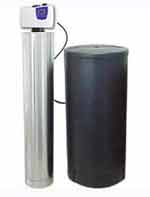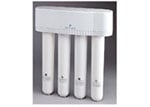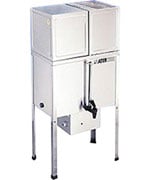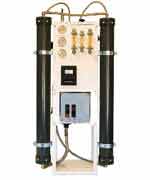Nitrate is a naturally occurring chemical compound that is formed in the soil when nitrogen and oxygen combine. Small amounts of nitrate are normal but large amounts can pollute groundwater and cause severe consequences to life.
Sources of nitrate in the soil are chemical fertilizers, septic system discharge and livestock waste. A portion of chemical fertilizer will convert to nitrate in the soil. Ammonia is present in the waste of both humans and animals. It enters the soil from inadequate or poorly managed septic systems. Plants can only absorb so much nitrate from the soil and the excess is then carried down through the soil into the groundwater by the action of rain, snowmelt and irrigation.
The consumption of small amounts of nitrate is not harmful; nitrate is actually apart of a normal diet. Health problems can occur however with ingestion of excessive nitrate. When nitrates enter the body, stomach bacteria converts nitrate to nitrite. Adults have low pH (high acidity) stomach acid that destroys this nitrite producing bacteria.
Infants however (especially those less than three months in age) do not have developed digestive systems that can destroy the stomach bacteria, so infants can develop excess amounts of nitrite in their bodies and develop methemoglobinemia. Methemoglobin is a converted form of hemoglobin, which is found in red blood cells and normally carries oxygen in the body's bloodstream. In methemoglobin form, these cells are unable to transport oxygen and these infants now become oxygen starved. Because oxygen starvation results in a bluish discoloration of the body, methemoglobinemia has been referred to as “blue baby syndrome”. Once an infant's system is fully developed (normally three to six months), methemoglobinemia is a rarely a problem. Methemoglobinemia, if recognized by a physician, is relatively easy to treat and babies can make a full recovery.
Livestock are also susceptible to nitrate poisoning however they too, can be treated and fully recover. For more information regarding methemoglobinemia or nitrate ingestion in general, please consult your family doctor.
The United States Environmental Protection Agency (EPA) recommends that well users test their water every one to three years for both total nitrate and biological content. If the taste, odor, or appearance changes, test the water more frequently. Nitrate is either expressed in reports as Nitrate-N (nitrate as nitrogen) or Nitrate as Nitrate. The maximum contaminant level (MCL) for nitrate-N is 10 ppm (also known as milligrams per liter). To express nitrate as nitrate, multiply by 4.4 The MCL for nitrate as nitrate is 44 ppm for instance.
The primary causes for nitrate contamination in groundwater are failed or overloaded or improperly constructed and located septic systems, animal waste and fertilizer. Water that comes in contact with these sources will absorb nitrate and carry it down into the soil eventually ending up in the groundwater.
EPA ecommends that property owners follow these simple steps and guidelines to reduce the risk of nitrate contamination:
- Reduce your use of fertilizer: use commercial fertilizers only when necessary, and always according to the manufacturer's recommendations. Never over-fertilize.
- Proper well construction: Your well should always be located up-gradient or in reverse direction of groundwater flow direction from your septic system. There should be a minimum of 100 feet separating your well from your septic tank and leach field whichever is the closer (contact your county health department as their requirements could be greater). Your wellhead casing should extend above the ground and be protected within an earth berm to divert surface drainage away from the wellhead. Make sure that the well casing has at least a 50 foot deep annular seal of cement (grouting around the well casing) and a concrete slab covering the wellhead.
- Operate and maintain your septic system correctly: Proper maintenance and operation of your septic system is a must and will in the long run save you a lot of money and avoid failure which will ultimately lead to groundwater contamination and the possibility of disease.
Follow these simple rules:
- Don't dispose of chemicals or non-biodegradable materials in your drain or toilet.
- Don't plant trees or shrubs near drain lines or the leach field.
- Don't drive vehicles over the septic tank or leach field.
- Have your septic tank pumped out at least every two to three years.
- Conserve water: If you have two leach fields, alternate their use yearly.
- Install a lint trap on your washing machine
Nitrate Removal Technologies
Nitrate removal technologies include: ion-exchange, reverse-osmosis, distillation, biodenitrification, and eletrodialysis. The most commonly used treatment approach is by ion-exchange, the same technology water softeners employ. With this type of system, chlorides are exchanged for the nitrate, and the high nitrate waste is flushed into a holding tank or drain field . Similar to a water softener, salt is added to a salt tank, and the nitrate resin is regenerated automatically with salt water.
For whole house treatment, or for small communities with nitrate in ground water, we offer custom systems for specific applications. Pretreatment and total system design is important. In California, and in many other states in the U.S., if you are looking for a nitrate filtration system for your small community water system, each system installed must be individually certified by the Health Dept. for nitrate removal. Typically all the water must be filtered, and individual point-of-use filters at kitchen taps are not allowed for compliance with the nitrate MCL standard, but the EPA is making some exceptions.
If you are on your own private well you can choose to either remove the nitrate through out the house, or purify at one or more faucets. Since bathing in nitrate is usually thought of as a health threat, it can more practical and less expensive to treat the for nitrate at one tap, often the kitchen sink.
Get help in selecting a nitrate filter system
Want More Information about well water? Visit USEPA site about Private Drinking Water Wells.
Test your well water for nitrate.
Get complete well water testing: See all well water test kits.










